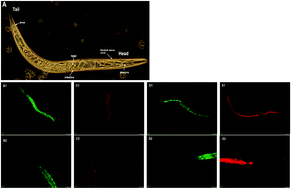MPA-capped CdTe quantum dots exposure causes neurotoxic effects in nematode Caenorhabditis elegans by affecting the transporters and receptors of glutamate, serotonin and dopamine at the genetic level, or by increasing ROS, or both
Abstract
As quantum dots (QDs) are widely used in biomedical applications, the number of studies focusing on their biological properties is increasing. While several studies have attempted to evaluate the toxicity of QDs towards neural cells, the in vivo toxic effects on the nervous system and the molecular mechanisms are unclear. The aim of the present study was to investigate the neurotoxic effects and the underlying mechanisms of water-soluble cadmium telluride (CdTe) QDs capped with 3-mercaptopropionic acid (MPA) in Caenorhabditis elegans (C. elegans). Our results showed that exposure to MPA-capped CdTe QDs induced behavioral defects, including alterations to body bending, head thrashing, pharyngeal pumping and defecation intervals, as well as impaired learning and memory behavior plasticity, based on chemotaxis or thermotaxis, in a dose-, time- and size-dependent manner. Further investigations suggested that MPA-capped CdTe QDs exposure inhibited the transporters and receptors of glutamate, serotonin and dopamine in C. elegans at the genetic level within 24 h, while opposite results were observed after 72 h. Additionally, excessive reactive oxygen species (ROS) generation was observed in the CdTe QD-treated worms, which confirmed the common nanotoxicity mechanism of oxidative stress damage, and might overcome the increased gene expression of neurotransmitter transporters and receptors in C. elegans induced by long-term QD exposure, resulting in more severe behavioral impairments.


 Please wait while we load your content...
Please wait while we load your content...